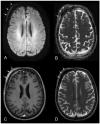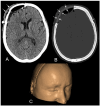Primary central nervous system mucosa-associated lymphoid tissue lymphoma: a diagnostic challenge
- PMID: 40740410
- PMCID: PMC12308279
- DOI: 10.1093/bjrcr/uaaf037
Primary central nervous system mucosa-associated lymphoid tissue lymphoma: a diagnostic challenge
Abstract
Primary central nervous system (CNS) mucosa-associated lymphoid tissue (MALT) lymphoma is a rare condition frequently mistaken for meningioma. Since these conditions require distinct treatment approaches, recognizing their imaging characteristics is essential for accurate clinical decision-making. A 69-year-old woman presented with headaches and forehead swelling, prompting MRI of the CNS. Suspecting an intracranial meningioma, the tumour board recommended surgical resection. However, histopathological analysis identified the lesion as a primary CNS MALT lymphoma. Follow-up revealed secondary cutaneous tumour infiltration, leading to a delay in adjuvant radiotherapy. Understanding the differential diagnoses of meningioma is critical for neuroradiologists and neurosurgeons to ensure appropriate treatment planning. This case highlights a misdiagnosis of meningioma that was ultimately identified as a primary CNS MALT lymphoma, emphasizing key imaging and clinical characteristics essential for distinguishing between the most important differential diagnoses of primary CNS MALT lymphoma.
Keywords: Erdheim-Chester disease; dural metastases; granulocytic sarcoma/chloroma; hypertrophic pachymeningitis; meningioma; neurosarcoidosis; primary CNS mucosa-associated lymphoid tissue lymphoma.
© The Author(s) 2025. Published by Oxford University Press on behalf of the British Institute of Radiology.
Conflict of interest statement
The authors declare that they have no known competing financial interests or personal relationships that could have appeared to influence the work reported in this article.
Figures





References
Publication types
LinkOut - more resources
Full Text Sources

